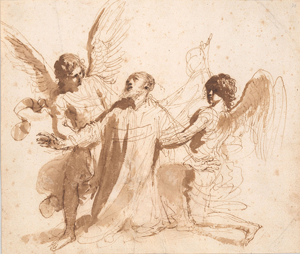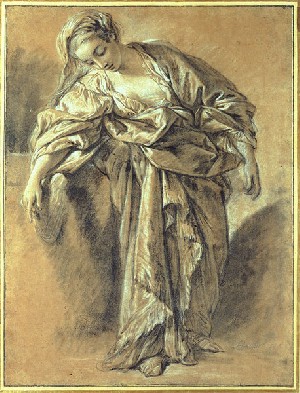Grounding the Vision
John Haberin New York City
Guercino Drawings
Conversations in Drawing: The Gray Collection
Saint Philip Neri had a vision of the Virgin in the heavens, but she did not lift him into the clouds. For Guercino, even a vision must stay close to the ground. It is in fact only the start of some very down to earth conversations at the Morgan Library.
François Boucher and Edgar Degas might not have had a whole lot to say to one another. Boucher's women were born to privilege, just as they seem to have been born into their stately gardens and luxuriant dresses. Dancers for Degas were barely adults and still struggling for grace. Boucher was ever so accepting, of royalty, pomp, and circumstance—while Degas was the eternal skeptic, bringing a cool eye even to subjects most in need of warmth. Yet there they are, side by side in "Conversations in Drawing" and talking up a storm.  These and other works from the Gray collection have a lot to say, too, good and bad, about the connoisseur's eye.
These and other works from the Gray collection have a lot to say, too, good and bad, about the connoisseur's eye.
The weight of a miracle
In Guercino's drawing, Philip collapses under the weight of a miracle, and only an angel to each side keeps him from falling. The Renaissance pyramid has collapsed, too, in the minor miracle called the Baroque. Still, in supporting the saint's outstretched arms, the angels all but give him wings. He in turn keeps them as earthbound as he or you. The study itself, in ink and brown wash, sticks to the bottom half of the painting in progress, to focus on the figures rather than the narrative—and to keep them grounded. For Guercino, received wisdom must compete with realism, and who knows which will win?
Guercino, who was probably self-taught, relied on both observation and artifice, and he can make it hard to know which is which. A selection of twenty-five drawings, all but two from the Morgan's astounding thirty-five by the artist, includes full sheets for ears and for noses and mouths. He must have walked the streets of Bologna, taking note of human variety. In line with psychology back then, he must also have sought not just diversity, but types. When he sketches a beggar holding out his tip jar like a precious object, it could be an act of sympathy or a fable with a moral. He does indulge in caricature, but more often he keeps his eyes open.
When the Frick borrowed from the Norton Simon Museum in 2009, it included a profile portrait of a dog—and, yes, portrait is not too strong a word to use. Guercino lends it individuality, musculature, and command, in contrast to dogs accompanying nobility in earlier art to the hunt. It is hardly Instagram, but still it is a dog picture, and he does tend to soften and to sentimentalize his influences, even as he adds weight. When he turns to red chalk, he is all smooth complexions and all smiles. Still, his first instinct is for what he knew. A river bank with bathers, drawn for its own sake rather than for a print or painting, parallels Claude Lorrain in France, but also the mix of genre painting and landscape in Dutch art to come.
More often than not, his drawings have a human impulse that he felt obliged to suppress on the way to a painting. In a study for Virgin of the Rosary in 1637, the infant Jesus clambers up his mother's neck, while accompanying saints look somewhere between amazed and aghast. Needless to say, they will end up in their place. Saint Philip in 1647 will lower his arms, and the face of Jesus at his mockery will show less suffering than on paper and more nobility. Executioners, in turn, start off with a heroic stance that towers above their saintly victims. Here, too, Guercino can see both sides of the story because bases his figures on both nature and art.
Born Giovanni Francesco Barbieri in 1591, he learned by studying the founders of the Baroque, including the Carracci brothers in Bologna. He could have seen a fallen saint in the arms of an angel in Saint Francis by such artists as Orazio Gentileschi, the father of Artemisia. The show opens with a man lying with his hands behind his back as if bound and his legs toward the viewer. To be sure, Guercino does not share the sexual longings and inner complexity of Caravaggio, but he had taken the older artist to heart. His black chalk dipped in oil stipples and sensualizes the man's skin. Only fear of disturbing an unquiet sleep keeps one from wanting to touch.
As here, the artist is at ease with movement and foreshortening, the very hallmarks of the Italian Baroque. Another man lies head first at the feet of Medea, who will bring him back to life. As cherubs take flight, Guercino looks over their backs and up to their butts. The show's title speaks of him as "Virtuoso Draftsman," and he adapted to a full range of drawing media—often as studies for prints. Still, for all his virtuosity, his art is all about bringing impulse under control. It could be in the interest of vision, piety, or the imagination.
Discernment and difference
One year later, François Boucher and Edgar Degas Degas open roughly a hundred works from the collection of Richard and Mary L. Gray. If Neoclassicism, Romanticism, and revolution turned Boucher's Rococo out of fashion, Degas and Post-Impressionism were the last nails in its coffin. Still, both their women were ill at ease. Boucher's might have been collapsing from the sheer weight of keeping up appearances. Both, too, were studies in mass and in motion, of rich clothing or flawed flesh. They were also displays of skill.
The Morgan makes a point of just that, to justify a collection, its promised gifts, and their platitudinous title. Richard, a Chicago dealer who died in 2018, and Mary, an art historian, were "more interested in skill than celebrity." They were, in other words, betting on some eminently forgettable names to please the discerning eye. Of course, there is a term for that, academic art, but the collectors might not have minded the accusation. They were out to shake up what counts as academic or the avant-garde. They leaned heavily on the late Renaissance and Mannerism, when the avant-garde was growing self-conscious and stale, to argue that it never fully will.
They indulged in Polidoro da Caravaggio, a pupil of Raphael, alongside Jackson Pollock, but not just to plead for the first. They also saw drip painting as mastery. Skill may be the last thing that comes to mind with Max Ernst and frottage, or rubbings, but he was composing a still life quite as much as his elders. More often, the key to skill here is the human body, at rest and in motion, and the show ditches chronology in favor of subject to bring it out. Paul Cézanne spent his life questioning his art and his skill, while Peter Paul Rubens to his right was anything if not confident. Yet a bather for Paul Cézanne has his outstretched arm, too.
 Juxtapositions like these bring a smile from surprise alone. If Jacques-Louis David had his classical warriors, Roy Lichtenstein drew Ajax in a helmet. Georges Seurat in the 1880s is not an everyday realist, but his nude wields his arm much as Hercules for François Lemoyne in 1717 wields a club. The brush of a typewriter eraser for Claes Oldenburg is making its wild gesture as well. The table at the Last Supper for David catches the light much like a bare table in the Borghese Chapel in Rome for J. A. D. Ingres. A black abstraction by Franz Kline concentrates the darkness of Seurat and Vincent van Gogh.
Juxtapositions like these bring a smile from surprise alone. If Jacques-Louis David had his classical warriors, Roy Lichtenstein drew Ajax in a helmet. Georges Seurat in the 1880s is not an everyday realist, but his nude wields his arm much as Hercules for François Lemoyne in 1717 wields a club. The brush of a typewriter eraser for Claes Oldenburg is making its wild gesture as well. The table at the Last Supper for David catches the light much like a bare table in the Borghese Chapel in Rome for J. A. D. Ingres. A black abstraction by Franz Kline concentrates the darkness of Seurat and Vincent van Gogh.
Surprise can bring genuine insight. Hercules from Annibale Carracci at the dawn of the Baroque interrupts resting figures by Pablo Picasso and Henri Matisse. Whether from laziness in old age or genius, Picasso had grown closer in his economy to the others. More often, Gray's gallery featured the likes of Jim Dine since 1960, and here Dine's self-portrait looks aging and ornery enough. It looks better, though, faced with the near caricature of staring men by Honoré Daumier and Jean Dubuffet. And then a fifteenth-century old man from an unknown hand humanizes them all.
Discernment also means attention to difference, but did either Gray take notice? Boucher and Degas really do differ in subject and in outlook, and Boucher achieves his mass by gradations of shadow, Degas his by spots of light. After an academic like Francesco Salviati, a figure from Guercino looks far rawer in its bright red chalk, its uncut hair, and its violence. But then he leads to the introspection and honesty of a pupil of Rembrandt, and the collectors must have seen it coming all along. By the show's end, the connoisseur's eye may feel once again like an evasion, for those (mostly male) who can afford it. Still, academic art with room for Willem de Kooning will for now be good enough for me.

Guercino drawings ran at the Morgan Library through February 2, 2020, drawings from the Gray collection through June 6, 2021.




